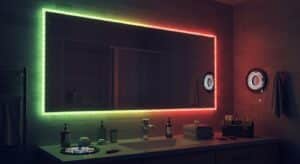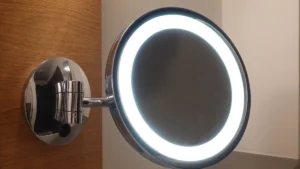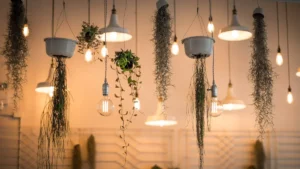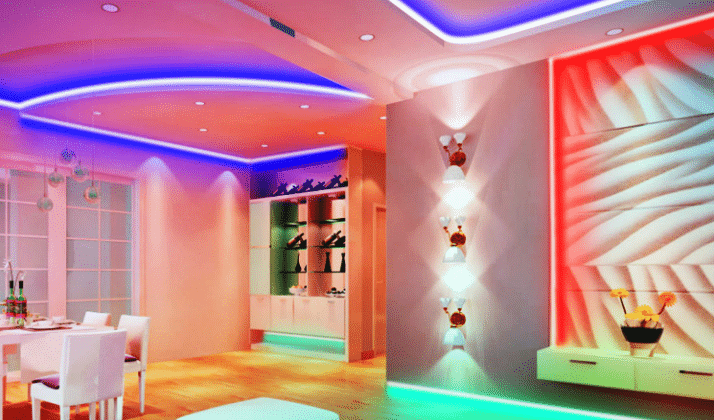
Smart LED strip lights are revolutionizing how you illuminate your home. They’re energy-efficient, consuming just 4 to 14 watts per meter, which saves money and reduces your carbon footprint. With a market projected to grow to $2.97 billion by 2030, these versatile lighting solutions offer endless customization and seamless integration with smart home systems.
Key Takeaways
Pick the right brightness and color for your LED strips. This helps set the mood in every room.
Measure your area carefully before installing to prevent mistakes. This ensures an easy and smooth setup.
Try fun uses for LED strips like accent lighting. Use them to improve entertainment areas or for holiday decorations. They make your home look better.
Choosing the Right Smart LED Strip
When selecting a smart LED strip for your home, it’s important to consider factors like brightness, length, and compatibility. Let’s break it down step by step.
Brightness and Color Temperature
The brightness of LED light strips, measured in lumens, determines how well they illuminate a space. For task lighting in areas like kitchens, choose brighter strips. For ambient lighting in bedrooms or living rooms, softer brightness works better.
Color temperature, measured in Kelvin (K), plays a big role in setting the mood. Warm tones (2700K–3000K) create a cozy vibe, perfect for relaxing spaces. Cooler tones (4000K–6500K) feel more energetic and are ideal for workspaces. If you want flexibility, go for color-changing smart LED strip lights. These allow you to adjust brightness and temperature to match the time of day or occasion.
💡 Tip: Most residential LED strips fall within the 2200K–6500K range, giving you plenty of options to customize your lighting.
Length and Flexibility
Smart LED strips come in various lengths, making them versatile for different applications. Here’s a quick guide:
Length (Meters) | Application Description |
|---|---|
1 Meter | Great for under-cabinet lighting in kitchens or bathrooms. |
2 Meters | Perfect for continuous lighting in shelves or retail displays. |
3 Meters | Best for larger spaces like living rooms, ensuring consistent illumination. |
Choose a length that fits your space to avoid unnecessary cutting or extensions. Flexible strips are also easier to install on curved surfaces or tight corners.
Compatibility with Smart Home Systems
To connect LED light strips with your smart home setup, ensure they’re compatible with popular systems like Alexa, Google Home, or Apple Siri. Many smart LED strip lights, such as the GE Cync Direct Connect, support Matter, making integration seamless. You can control them via voice commands or smartphone apps for ultimate convenience.
🛠️ Pro Tip: Check if the LED strip works with your existing home automation hub, like SmartThings or Wink, to avoid compatibility issues during installation.
By considering these factors, you’ll find the perfect smart LED strip to enhance your home’s lighting and functionality.
How to Install Smart LED Strip Lights
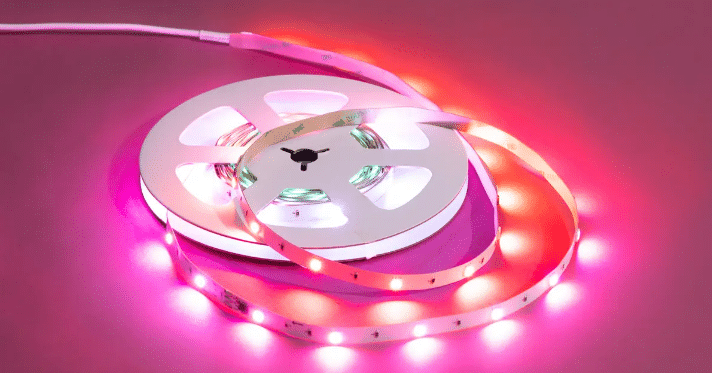
Measuring and Preparing the Area
Before you install led strip lights, take a moment to measure and prepare the area. This step ensures a smooth installation process and avoids unnecessary mistakes. Start by grabbing the right tools:
Measuring tools like a tape measure or ruler for accurate dimensions.
Cutting tools such as scissors or a utility knife for trimming the led light strips.
Connectors for easy connections without soldering.
Cleaning supplies like alcohol wipes to prep the surface.
Measure the length of the area where you’ll install the lights. If you’re planning above-cabinet lighting or under-cabinet lighting, double-check the dimensions to avoid cutting errors. Once you’ve measured, mark the spots where the strip will go. This will act as your guide during installation.
💡 Tip: Always leave a little extra length when measuring. It’s easier to cut led light strips than to extend them later.
Cleaning and Securing the Surface
A clean surface is key to proper adhesion. Use alcohol wipes or a mild cleaning agent to remove dust, grease, or debris. This step is especially important for areas like kitchens or bathrooms, where surfaces can get oily. Let the surface dry completely before moving on.
If the surface is uneven or the adhesive on the strip isn’t strong enough, consider using double-sided tape or additional adhesive. For tricky spots, mounting clips or brackets can provide extra support.
🛠️ Pro Tip: Test the adhesive on a small section first to ensure it sticks well to the surface.
Applying and Adjusting the LED Strip
Now it’s time to set up the smart led light strip. Peel off the backing from the adhesive and carefully stick the strip along the marked guide. Press firmly to ensure it adheres properly. For curved or tight spaces, flexible strips make the job easier.
If you need to cut the strip, make sure to do so only at the designated cut points. Use connectors to join sections or to connect led light strips to the power supply. Once everything is in place, plug in the strip and test it. Adjust the positioning if needed to achieve the perfect mood lighting.
⚠️ Note: Always use the correct power adapter to avoid voltage mismatches that could damage the strip.
By following these steps, you’ll know exactly how to install smart led strip lights and create stunning lighting effects in your home.
Creative Ways to Use LED Light Strips
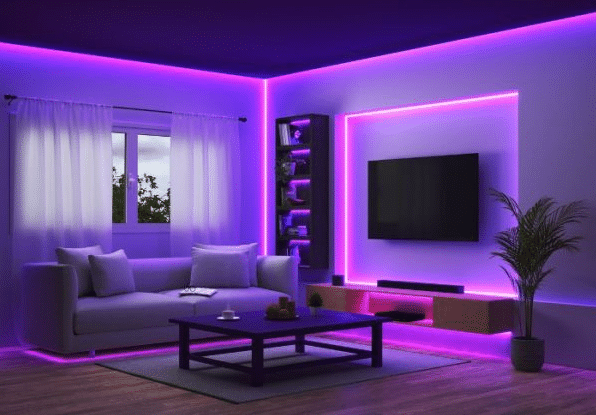
Accent Lighting for Ceilings and Walls
Smart LED strip lights can transform your ceilings and walls into stunning focal points. You can use color-changing LED strips to adjust hues for different occasions, creating the perfect mood for any space. For a soft, indirect glow, try cove lighting by placing the strips in recessed areas of the ceiling. This works great for living rooms or bedrooms.
Want to make a bold statement? Install LED strip lights in patterns on an ordinary wall to create an accent wall that stands out. You can also highlight architectural details with perimeter ceiling lighting or add a luxurious touch by placing strips behind mirrors for a halo effect.
💡 Tip: Use LED strips along baseboards or behind TVs to create a captivating ambiance that enhances your room’s overall lighting.
Enhancing Entertainment Spaces
Your entertainment spaces deserve lighting that matches the excitement. Smart LED strip lights let you customize illumination to highlight specific areas, like around your TV or gaming setup. This not only reduces eye strain but also creates a mesmerizing atmosphere.
For gaming rooms, you can take it up a notch by syncing the lights with in-game events. Imagine the colors dynamically changing to match the action on screen—it’s like stepping into another world! In home theaters, install LED strip lights along furniture or walls to provide a soft glow that complements the on-screen visuals.
🎮 Pro Tip: Use flexible strips to easily install lights around curved furniture or tight spaces for a seamless look.
Seasonal and Decorative Applications
LED light strips are perfect for seasonal and decorative purposes. During the holidays, wrap color-changing strips around your Christmas tree or drape them over the mantel for a festive vibe. You can also line windows with LED strips to create a cheerful glow that brightens up your home.
For everyday decor, install LED strips under cabinets, along bookshelves, or above crown molding to create inviting ambient lighting. Want something unique? Use shades of deep purple and calming blue to mimic a night sky, turning your ceiling into a serene escape.
✨ Idea: Highlight staircases or alcoves with LED strips to showcase your home’s unique features while adding a touch of elegance.
Smart LED strip lights offer a perfect blend of functionality and style for your home. They consume up to 80% less energy than traditional bulbs, reducing your electricity bills and carbon footprint. Plus, their long lifespan minimizes waste. You can install them along stairways for safety or under shelves for task lighting.
With features like smart home integration and customizable colors, these strips adapt to your needs. Whether you want to enhance your workspace or create a cozy ambiance, they’re a versatile solution. Explore the possibilities and let smart LED strips transform your home’s lighting into something extraordinary.
FAQ
How do I control smart LED strips with my phone?
You can use the manufacturer’s app. Download it, connect your LED strip to Wi-Fi, and customize colors, brightness, or schedules with ease.
Can I cut smart LED strips to fit my space?
Yes! Look for the marked cut points on the strip. Use scissors to trim carefully. Avoid cutting outside these points to prevent damage.
Do smart LED strips work without Wi-Fi?
Absolutely! Many strips include a remote or manual controls. However, Wi-Fi enables advanced features like voice commands and app-based customization.
💡 Tip: Check the product description to confirm offline functionality before buying.
See Also
Selecting The Perfect LED Strip Lights For Linear Lighting
Effective Installation Tips For RGB LED Strip Lights
New Developments In Dimmable COB LED Strip Lighting

